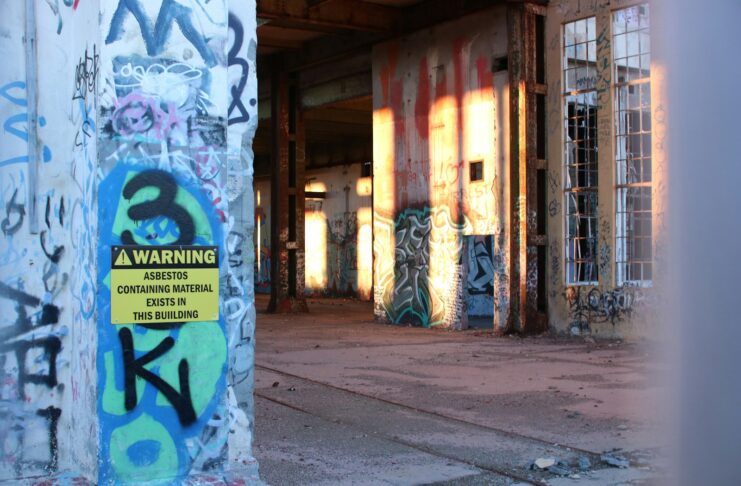A self-employed roofing contractor has been sentenced to 200 hours of unpaid work after failing to control the spread of asbestos, leading to contamination in a residential area.
The Health and Safety Executive (HSE) prosecuted Stephen Wilks, trading as S Wilks Roofing, after an investigation found that workers under his supervision were exposed to asbestos-containing materials without proper safety measures in place.
The case demonstrates the ongoing risks of asbestos exposure in construction and maintenance work, despite the material being banned in the UK more than two decades ago. Employers have a legal responsibility to ensure workers are protected from asbestos-related health hazards, but unsafe practices like those seen in this case continue to put lives at risk.
Asbestos Mishandling Caught on Camera
Wilks had been hired to replace the roofs of three garages in Bowden, Altrincham in February 2022. A local resident reported concerns after debris fell into their garden, prompting an HSE investigation. Analysis confirmed the debris contained chrysotile asbestos, one of the most commonly used forms of the material.
Doorbell camera footage showed workers under Wilks’ supervision improperly handling asbestos waste and disposing of it in household bins. Inspectors later found ripped bags of asbestos stored in a publicly accessible area, with fibres spilling onto the ground and contaminating nearby undergrowth. Personal belongings stored in the garages were also affected.
Although the property management company that hired Wilks later arranged for a licensed contractor to carry out safe removal and decontamination, the damage had already been done. The HSE stressed that the risk could have been avoided if proper asbestos safety measures had been followed from the start.
Wilks pleaded guilty to breaching The Control of Asbestos Regulations 2012 on March 28. At Ashton-Under-Lyne Magistrates’ Court, he was sentenced to a 12-month Community Order, including 200 hours of unpaid work, and ordered to pay £3,582.13 in costs.
HSE Inspector Phil Redman warned that failing to follow asbestos safety laws puts both workers and the public in danger.
“This was a serious incident that put Mr Wilks, those working under his control and members of the public at risk from the potential harmful effects of being exposed to asbestos-containing materials,” he said.
“Duty holders are reminded to ensure they fully control the risks associated with the removal of asbestos-containing materials that do not require removal by a licensed asbestos removal contractor.”
The UK’s Asbestos Ban – But Why is it Still a Problem?
Asbestos, widely used for insulation, roofing and fireproofing, was completely banned in the UK in 1999, after decades of scientific evidence linked it to serious and often fatal health conditions. But the material remains present in many older buildings, particularly those constructed before the 1980s.
According to the HSE, asbestos can still be found in homes, schools, hospitals and workplaces, often in roofing, insulation, pipe lagging and ceiling tiles. When left undisturbed, the material poses little risk, but if it is damaged or removed incorrectly, its microscopic fibres can be released into the air and inhaled.
It’s particularly dangerous for workers in trades such as construction, maintenance, demolition and refurbishment, where disturbing asbestos is a common risk. Even office workers in older buildings can be exposed if maintenance work is carried out without proper asbestos management.
Health Risks: The Silent Killer in Workplaces
Asbestos exposure is the leading cause of work-related deaths in the UK, with around 5,000 deaths each year linked to past exposure. The most serious health conditions caused by asbestos include:
- Mesothelioma – A rare but aggressive cancer that affects the lining of the lungs or abdomen. It is almost always caused by asbestos exposure and is usually fatal.
- Asbestosis – A long-term lung disease caused by prolonged exposure to asbestos fibres, leading to severe breathing difficulties.
- Lung cancer – Asbestos-related lung cancer is similar to smoking-related lung cancer and has a high mortality rate.
- Pleural thickening – A condition where the lung lining becomes scarred, leading to breathing difficulties and chest pain.
The long latency period of asbestos-related diseases means symptoms may not appear until 20 to 50 years after exposure. Many workers who were exposed decades ago are only now being diagnosed with fatal illnesses.
Employer Responsibilities Under the Law
The Control of Asbestos Regulations 2012 set out strict requirements for employers to protect workers from asbestos exposure. Key legal duties include:
- Identifying asbestos risks – Employers must assess whether asbestos is present in a building before any work is carried out.
- Conducting risk assessments – A thorough risk assessment must be completed to determine how asbestos can be safely managed.
- Providing training – Workers who may come into contact with asbestos must receive proper training on how to handle it safely.
- Using correct removal procedures – In some cases, only licensed asbestos removal contractors can legally remove asbestos. Even in cases where a licence is not required, strict safety measures must still be followed.
Failure to comply with these laws can result in prosecution, heavy fines and, in serious cases, imprisonment. More importantly, it puts workers’ health and lives at risk.
HSE’s ‘Asbestos and You’ Campaign
To raise awareness, the HSE is running an “Asbestos and You” campaign, aimed at tradespeople who may unknowingly come into contact with asbestos. The campaign highlights the importance of recognising asbestos-containing materials and using safe working practices.
Employers and workers can access guidance on asbestos safety, including how to identify asbestos and what to do if they suspect its presence, on the HSE website.
Protecting Workers: A Priority for Employers
The sentencing of Stephen Wilks serves as a reminder that asbestos safety should never be taken lightly, say experts. While the UK banned asbestos years ago, its presence in older buildings means that exposure risks remain high for workers.
Employers must take their legal responsibilities seriously, ensuring that asbestos risks are properly managed and that workers are fully protected. Cutting corners on safety can lead not only to legal consequences but also to devastating long-term health effects for those exposed.


